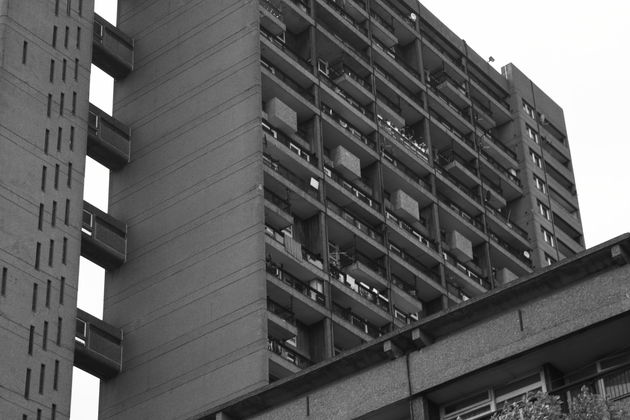 Trellick Tower by Erno Goldfinger. Photo by Jonathan Retico
Trellick Tower by Erno Goldfinger. Photo by Jonathan Retico
Probably the twentieth century’s most controversial movement, Brutalism was characterised by its utilitarian style, modular elements and the functional use of concrete and steel
The architecture movement that loved concrete fell from grace in the 1970s, but has had a resent resurgence in popularity, perhaps because of its graphic ‘instagrammable’ look and formidable facades.
Based on socialist principles, Brutalism began in Europe with Le Corbusier’s Unite d’Habitation, a housing estate in Marseille designed and built for the working classes. Devoid of ornament and directed towards creating social bonds between residents, Unite d’Habitation laid the framework for Brutalism in both aesthetic and programming. The French architect and co-founder of the Bauhaus school had a career-long love affair with concrete and the material came to be the go-to for the movement.
Le Corbusier designed his Unité d’Habitation in line Modernism’s early utopian aspirations and his personal guiding principles of the five points of architecture: for example Unité d’Habitation was lifted onto pilotis and topped with a roof terrace. The 12-storey building had interior streets – predecessors of the ‘streets in the sky’ that became synonymous with the social housing projects of the 1960s and 1970s. These were aimed at simulating the kinds of social interactions that might be had on the street.
Although inspired by the essence of Modernism, Brutalism was a departure from the luxuriousness of its sister movement. Materials were left in their raw, unfinished states and as opposed to the lightweight structures of the Modernist movement, Brutalist buildings were often solid, block-like structures.
 Unité d’Habitation in Marseille. Photo by André Meyer-Vitali
Unité d’Habitation in Marseille. Photo by André Meyer-Vitali
Brutalism was born as part of an ambitious vision for urban utopias that could be created through a new architectural style. It was popular among communist countries in Europe and many of its disciples shared a socialist ideology. The buildings were bold and often imposing, the materials left bare. Brutalism was popular in the mid-1950s to the mid-1970s, used predominantly in institutional buildings. Many brutalist architects were commissioned to build schools, public housing, churches and government buildings.
Though it is commonly assumed that the name is linked to the movement’s rather ‘brutal’ look, the term Brutalism is actually derived from the French term ‘béton-brut’, which means ‘raw concrete’ – the movements signature material.
In post-World-War-II London housing was in such short supply that new Brutalist developments seemed to offer an affordable solution. The buildings were intended to be democratic and open to everyone. Brutalism defined the architecture of Britain in the 1960s and Brutalist, not just in the social housing that appeared all over the country, but also in transport buildings and tertiary educational facilities.
The Barbican Centre and Estate is a notable example of Brutalist architecture in Britain. The massive arts centre and housing development – designed by Chamberlin, Powell & Bon in the 1960s – is located in one of the most heavily bombed areas of London. It is a labyrinth of sky bridges, walkways, tunnels and corridors that were intended to give precedence to the pedestrian over the vehicle and features a series of communal outdoor areas in the form of internal gardens.

When the Queen officially opened the centre in 1982 she called it one of the ‘wonders of the modern world,’ but in 2003 it was voted London’s ugliest building.
The infamous Brutalist housing estate Robin Hood Gardens is the manifestation of the progressive social ideas that were the driving forces of brutalism. It was the first major work of architects Alison and Peter Smithson and was almost immediately seen as a failure. It was designed in the late 1960s during Brutalism’s pinnacle, but opened in 1972 as the movement began to collapse.
Built under all the guiding principles of Brutalism, it came to represent everything that was wrong with the movement. The poverty that the estate had hoped to ease was exaggerated by high crime rates and vandalism in the communal areas, which were all badly maintained. Now in partially demolished state, a section of Robin Hood Gardens – called a concrete monstrosity by some – has been acquired by the V&A Museum.

Many of the buildings failed to bring around the paradises their architects hoped for. The top-down policies that guided the design were seen as inhuman and many buildings were blamed for fostering crime and perpetuating poverty. It didn’t help that the concrete, used more extensively on these projects than it had been used before, didn’t age well and showed signs of water damage – quickly coming to signify of urban decay. Many Brutalist structures have been demolished.
In the 1980s Brutalism gave way to postmodernism and high-tech architecture, which both had more expressive and unpredictable forms and programming. In 2015 a series of books were published on the subject of Brutalism and the movement seems to have had a revival in popularity. The once loved then scorned movement is seen as a highly influential the architecture of the last century.

















